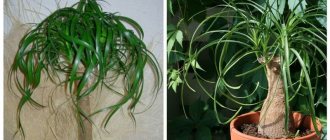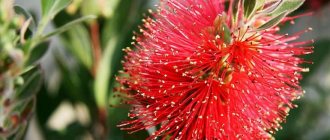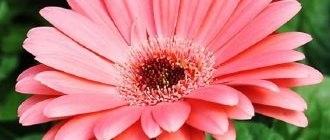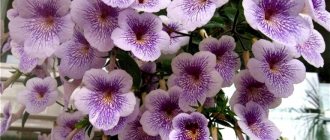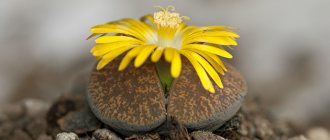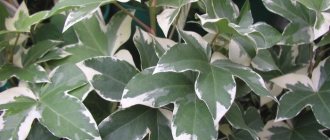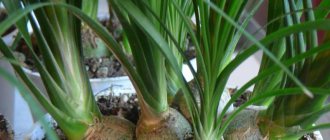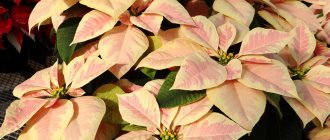Jacaranda is a tree or shrub from the Bignoniaceae family. A tall (sometimes over 20 m) perennial plant has graceful double-pinnate leaves reminiscent of a fern.
Due to its clear resemblance to the ancient plant, jacaranda is sometimes called a fern tree. In its natural environment, the shrub is common in India, Mexico, and Israel. The homeland of jacaranda is the tropical zones of South America. You can grow a tree at home without much hassle. It grows intensively, growing by 0.25 m every year. An adult plant can reach about 2 m if it is not pruned in time. Indoors, jacaranda blooms very rarely, but in nature, flowering occurs in winter or mid-spring.
Numerous purple flowers, similar to bells, form at the tips of fragile shoots. The flowers are collected in large paniculate inflorescences. Jacaranda has another name - Violet tree, derived from the similarity in color of the plants.
Pay attention to the heliconia flower, it looks very impressive.
| The growth rate is high, up to 30 cm per year. |
| It blooms very rarely, in winter or mid-spring. |
| The plant is difficult to grow. |
| It is a perennial plant. |
Botanical description
Jacaranda is a perennial plant of the Bignoliaceae family. Refers to decorative deciduous species. Natural habitat - Mexico, Brazil, South America, Bolivia, Zimbabwe. This plant can thrive both on the plains and in the mountains.
The height of the violet tree reaches up to 30 meters if it grows in outdoor conditions.
In indoor conditions, jacaranda can reach a maximum height of 3 meters. In this case, the plant will not bloom. The tree trunk is smooth, the branches are large and spreading. The leaves are complex in shape, very similar to a fern, and can reach 40-50 cm in length.
The splendor of jacaranda will surprise even a sophisticated connoisseur - its purple flowers with a lilac tint, reaching 3 cm in diameter, are collected in huge bouquets of inflorescences (about 30 flowers), which completely cover the crown during flowering. Sometimes there are specimens with white flowers. It is noteworthy that the tree blooms twice a year.
At the end of flowering, fruits appear on the branches in the form of pods with black seeds. The seeds can be used for subsequent propagation of the tree.
The violet tree deserves attention not only for its attractive appearance, but also for the value of the wood. It is often used to create expensive interior items, as well as various decorative elements and musical instruments.
It is also known that the plant is used in alternative medicine to cure rot.
The only variety suitable for growing indoors is jacaranda mimofolia, which has two varieties - Delta and Magdalena.
Let's talk about the varieties of this extraordinary tree in more detail.
Is Jacaranda suitable for bonsai?
The plant is used for cultivation using Japanese bonsai technology. This allows you to control the growth of the crown and leaves, as well as create your own miniature garden. There is even a separate variety of jacaranda, “Bonsai Blue,” which does not reach a length of more than 75 centimeters. For cultivation, the following conditions must be met:
- in the first year you cannot prune it;
- in the second year, cut to 10 cm and wait for side shoots to appear;
- then pinch the jacaranda, trimming the leaves and crown;
- to form the crown, you can use soft wire, which must be removed after 3 months;
- It is better to cut off all large leaves;
- Jacaranda will branch worse when standing in the shade.
Varieties and photos
Below are photos and descriptions of jacaranda varieties suitable for propagation and care in greenhouses and at home.
Mimosolifolia
The second name is oval-leaved jacaranda. It grows in the coastal zone of Argentina, Brazil and Bolivia. This variety has a non-branching straight trunk with a lush crown formed from large feathery leaves.
During flowering, the crown is abundantly covered with blue flowers , which reach up to 5 cm in length and 3 cm in diameter. There are small whitish spots on the surface of the flowers. The photo below shows Jacaranda Mimosolia:
Delta
This variety is intended for indoor cultivation and, with proper care, will delight you with the beauty of its fern-like, openwork leaves of light green color. The maximum height of the Delta jacaranda is 2 meters. You can see what the Jacaranda Delta variety looks like in the photo below:
Magdalena
The Magdalena variety is distinguished by the fact that it almost never blooms in indoor conditions. To do this, it needs open ground, which should be planted after reaching a height of two meters. Magdalena looks impressive in office and retail spaces.
Fluffy
Another name is jasmine jacaranda. It grows in South America, reaching 15 meters in its natural environment. The tree got its name for the complex shape of its leaves , thanks to which its crown becomes very voluminous. Purple flowers are attached to a paniculate inflorescence, but achieving flowering, as with other varieties, is quite difficult.
You can see what a jacaranda blossom looks like in the photo below:
How does it bloom?
In nature, jacaranda grows up to 15 meters in height and has wide, pinnately dissected leaves with an elongated light green blade. The tree has large inflorescences with five dozen purple to bluish flowers with jagged calyxes and bell-shaped, slightly drooping and curved corollas.
Jacaranda mimosa has purple-blue inflorescences with small calyxes. The plant with flowers can be seen more often in October and early November. Indoors it blooms twice a year: in spring and autumn. Magdalena and Delta varieties are also used for cultivation.
Care
Jacaranda is demanding to care for. This mainly concerns maintaining the desired temperature and humidity. However, if all conditions are met, the plant will bloom luxuriantly and add a touch of grace to the overall composition of the garden or park. Let's talk about how to care for a violet tree.
Lighting and placement of the pot
The plant feels great in the eastern or western part of the house, because... the south side is dangerous due to direct sunlight, and the north due to lack of heat.
The purchased tree must be accustomed to bright light gradually , otherwise burns may appear on its leaves and it will die. After getting used to it, the pot can be placed in bright sun, but only for a couple of hours a day.
Temperature
The violet tree is accustomed to tropical and subtropical climates. Therefore, it needs to maintain high temperatures. 22-24 degrees is the optimal level that should be followed for growing jacaranda.
In winter you can reduce the temperature to 19 degrees. The lower limit is 16 degrees during the cold period.
To form a beautiful crown, the pot with the plant must be rotated periodically.
Watering and humidity
The plant requires moderate watering. It is necessary when the top layer of soil has dried out. In winter and early spring, when leaves change, watering must be significantly reduced .
However, make sure that the soil is sufficiently moist. Due to the climate in which the violet tree grows, it needs high air humidity. It needs to be sprayed daily with warm water, and for greater effect, pour a little expanded clay into the pan and pour water.
To ensure the tree grows healthy, use well-settled, soft water for watering.
Top dressing
In the warm season - summer and spring, jacaranda needs to be fertilized. Feeding is done approximately 2 times a month . Fertilizers based on phosphorus and superphosphate are considered the most suitable for violet trees. They are best used dry, but concentrate can also be used.
In winter and during the shedding of leaves, the tree should not be fertilized.
Among organic fertilizers, peat, manure, bird droppings, sawdust, tree bark or silt are well suited.
Complex mineral fertilizers , such as “Superphosphate”, “Urea”, “Ammophos”, are widely popular among flower growers.
“Kornevin” and “Heteroauxin” are often used for feeding jacarandas. Feeding can be alternated with each other - this approach promotes healthy growth of the tree.
How to trim?
To form a beautiful tree crown, you need to pinch the tips of the shoots in the spring. The plant is characterized by rapid growth, and therefore its trunk quickly stretches out and becomes bare.
Transfer
It is better to replant jacaranda in the spring as the root system grows . For this, it is important to properly prepare the soil. A mixture of humus with the addition of river sand and peat in equal proportions is suitable.
Provide the plant with a good drainage layer to avoid stagnation of water at the bottom of the flowerpot, which can cause rotting of the tree roots.
Possible difficulties during cultivation
Many gardeners characterize jacaranda as an unpretentious plant that is resistant to diseases and pests. But if the rules of agricultural technology are violated, problems may arise: leaves turn yellow, curl or fall off, roots rot, and pests attack. To prevent the death of a plant, you need to promptly respond to any changes in its appearance. If the leaves have faded, curled or turned yellow, you need to inspect the plant for pests. Some types of insects are so small that they are not immediately noticeable. In this situation, you need to treat the plant with a universal-purpose insecticidal preparation.
If leaves fall during the winter, this should not be a cause for concern. A natural seasonal process occurs. But if this happened at an unspecified time and quickly, then the reason for this may be a sharp change in the temperature in the room or drying out of the soil. The crown may thin out if hard water is used for irrigation after the soil has dried.
Jacaranda is resistant to fungal infections. But with overwatering and stagnation of water, rotting of the roots may begin. Good drainage will help avoid this. Unnatural elongation of shoots can often be observed. This is the first sign of the development of chlorosis. To get rid of the problem, you need to add preparations that contain iron to the soil.
With proper care and compliance with all the rules of agricultural technology, you can grow a beautiful plant that will become a real decoration of any interior.
Reproduction
The violet tree can reproduce in two ways - with seeds and cuttings. We will tell you how this happens further.
Cuttings
A fairly simple method consisting of several steps:
- First of all, cut the cutting and dry it for several days in a dry, dark place.
- Place it in a heteroauxin solution so that it grows roots faster.
- Plant the cutting in moist soil at an angle of 45 degrees. Don't forget to add some peat and river sand to the soil.
- Cover the future tree with film, ensuring sufficient temperature for plant growth - 25 degrees.
Seeds
At home, planting jacaranda seeds should be done in the spring , after placing them in a moistened cloth for a day. Afterwards, the seeds are covered with a thin layer of soil (1 cm) and watered well. Favorable temperature for growing is 22-24 degrees. Germination time is 2-3 weeks.
You can see what jacaranda seeds look like in the photo below:
Jacaranda loves the sun, and therefore seedlings should be placed in a well-lit place. Grown plants will need to be planted in separate pots with a diameter of 7 cm, and subsequent transplants will be made as they grow.
Amaranth Peltogyne
The Amaranth tree belongs to the legume family (lat. Fabáceae) and the subfamily Caesalpiniaceae (lat. Caesalpiniaceae). Botanical name: Peltogyne spp., Peltogyne venosa. Another name is purple tree.
Amaranth is also called Purple Heart, the tree received this name due to the color of its bark.
The genus contains 23 species of flowering plants native to the regions of Central and South America, where they are found in the tropical forests of Brazil, Guyana and Suriname, with the majority of species native to the Amazon.
Botanical description
A tree growing in height 30-50 m, with a trunk diameter of up to 1.5 m. The leaves are alternate, divided into symmetrical pairs of large leaflets 5-10 cm long and 2-4 cm wide. The flowers are small, with five white petals, collected in panicle inflorescences. The fruit is a pod containing a single seed.
Wood
The sapwood occupies approximately 3 to 6 centimeters, and is painted brown with a noble bronze tint. It is noteworthy that initially the heartwood is gray-brown, but after sawing it acquires a rich purple hue. This happens because when interacting with a humid environment and light, the core oxidizes. The pores are quite large and randomly located, and the annual rings are barely noticeable. It has a medium-fine texture with good natural shine and a slightly wavy pattern.
Mechanical properties of wood
Amaranth is a very hard, extremely dense (860 kg/m³) and waterproof wood. But, unfortunately, it has one significant drawback - fragility. Wood is easily amenable to any mechanical processing. However, it is worth considering that the edge of the instruments may become dull over time, because Amaranth produces gum.
Dries quickly and does not require additional drying. It is also worth considering that wood is compressed in the radial direction by 4.6%. In general, wood is resistant to atmospheric influences and has a second strength class. The Brinell hardness is 5.4 kgf/mm², and the flexural modulus is 16900 N/mm.
Amaranth wood is resistant to attacks by various insects and fungi, but is susceptible to the influence of marine mollusks. Allergy to Amaranth occurs extremely rarely.
Application
Amaranth is extremely popular among consumers due to its expressive purple color. Amaranth boards are used to make furniture and art objects. Excellent strength is another advantage of Amaranth. Therefore, it is used in areas where objects are subject to constant loads. For example, they are used to cover floors, cladding cabins or for the production of sports equipment.
Interesting Facts
The parquet floors of the Winter Palace in St. Petersburg are made from this particular type of wood.
Uncontrolled logging in areas of natural growth has put some amaranth species at risk of extinction.
In our store you can buy:
- natural veneer Amaranth
- Amaranth block
Pests and diseases
Pests often attack this beautiful tree, and therefore you should always know how to combat them. Among the most common parasites :
- Aphid. First of all, it attacks the young leaves of the plant, causing them to curl and become sticky, and gradually the plant dies. If the aphid infestation is minor, treating with a soap solution will help. In other cases, special preparations are recommended: Actellik, Derris, Fitoverm.
- Whitefly. Its larvae can be seen on the bottom of the leaves, which quickly curl, begin to turn yellow and fall off.
- Spider mites are a common pest of indoor plants that entangle the lower part of leaves with their web. The reason for its appearance can be either infection from another plant or improper care, namely low air humidity.
- Small white midges are another enemy that likes to attack jacarandas. To cope with it you will need to spray with one of the drugs: Fufan, Inta-vir, Actellik.
Diseases to which a plant can be exposed are associated with a number of external factors. The most common:
- Leaf chlorosis. Possible reasons: high lime content in the soil, lack of moisture, deficiency of magnesium, sulfur, zinc, iron. This disease is characterized by yellowing of leaves and slow growth. To combat chlorosis, you will need to transplant into fresh soil and high-quality fertilizing with fertilizers.
- Root rotting. It is associated with stagnation of water in the lower part of the flowerpot and the lack of a drainage layer. If a disease is detected, the tree should be replanted and watering should be suspended for a while.
- Leaves turn yellow and curl. This behavior is typical for jacaranda both in the presence of pests and for the most common reasons - too dry air, lack of watering, low room temperature, drafts.
Transfer
To prepare a jacaranda for transplanting you need:
- treat the leaves with a protective spray and trim them;
- prepare a new pot and soil;
- add fresh humus to the soil;
- treat the soil with phosphates.
A transplant may be needed:
- after the purchase;
- because the flower has grown and the pot is cramped;
- due to improper soil;
- due to flower diseases.
Replanting during flowering is undesirable, but is possible only if the plant has been attacked by pests and are beginning to approach the root system.
Photo gallery
quietbackwater
sushko.yana
k_juls
kosmetolog.tatsiana
elena_zhura
greenmakerorg

